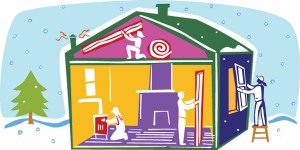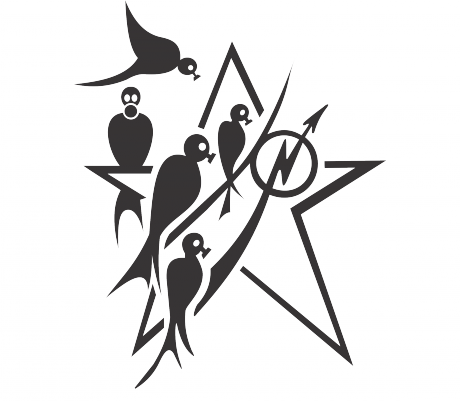 Preparation for winter (aka “winterisation”) for squats has some specific material needs, indeed. We need to make buildings windproof and thermoinsulated. We need to provide people with beds (almost 100% sleeps on the floor) or at least with better padding. We need to stop drafts inside buildings (they are mostly public ones, like schools, with huge staircases and corridors — a lot of space for cold drafts).
Preparation for winter (aka “winterisation”) for squats has some specific material needs, indeed. We need to make buildings windproof and thermoinsulated. We need to provide people with beds (almost 100% sleeps on the floor) or at least with better padding. We need to stop drafts inside buildings (they are mostly public ones, like schools, with huge staircases and corridors — a lot of space for cold drafts).
The materials we use are a bit uncommon, but tested in squatting conditions in Poland and Greece, so if used properly, they provide basic comfort and safety.
1. Making the building windproof.
1.1. Glazing.
This one is a no-brainer. Every broken or missing glass pane has to be replaced. If the crack is minor and we are short in money and workpower (we always are), good old duct tape can keep the pane together and make it airtight.
If the pane is big or there is no way to put the glass on, we can use twin wall polycarbonate, plexiglass, or even clear gardening PVC foil. If possible, we avoid using non-transparent materials. Winter is dark and people are enough depressed already. They will need as much light as possible to get through the season. Also, using cardboard and other non-water-resistant materials is a bad idea. Winter in Greece means a lot of wind and rain.
Whatever we put as glazing, there are several ways to fix it. Standard silicone putty, mounting glue, hot glue — and the tape as well. Tape will also help us cover the gaps between the widow and the frame (remember, if you tape the windows shut, always leave one that can be opened for ventilation — mold is a standing problem in the wintertime).
1.2. Filling the gaps
The best (but expensive) way to keep the doors and windows windproof are rubberfoam seals. You need to measure your average gap to fill and buy the seal of specific thickness. Otherwise, if you can keep the door or window shut until the spring, you just fill the gap with paper, textile or anything and seal with the duct tape.
1.3. Keep the drafts at bay
There are three major ways to stop chilly air streams within the building and keep warmer air where it belongs:
- Curtains and partitions. Use heavy tarps to separate big spaces into smaller sections, to block the wind from outside door, to cut off unused parts of the building. If the tarp is metalised, put the silver side towards warmer part of the building.
Wherever possible, raise wooden partitions with door. It provides better comfort and insulation. - Drop ceilings. High ceilings mean a lot of air to warm — and a lot of space for drafts. Spread ropes at some 2.5 m level and put tarps (silver side down) as a false ceiling.
- Door skirts. Staple narrow piece of cloth to the bottom of the door, to close the gap.
2. Thermal insulation
There are two challenges in this area. To keep living spaces as warm as possible and to keep people’s bodies as warm as it is comfortable. We recommend three basic ways to achieve it.
2.1. Emergency extra glazing.
The simplest way to keep the heat in is to add insulation layer to the window. We cannot make squat windows double or triple glazed, but we can put bubble wrap on most of the panes (especially those which do not need to be fully transparent). For best effect, use large (~2.5 cm) bubbles. Wash the window clean and apply the wrap flat side to wet glass. Secure edges with the duct tape and wait till spring.
2.2. Beds or extra padding for sleep.
In the winter, sleeping on the floor sucks. Not only the floor itself gets colder every week (the worst situation is in March, when the building is significantly colder than the outside), but also the cold air is heavy and during the night it is highly uncomfortable to sleep low.
Our best recommendation is to get beds for everyone, especially bunk beds. We (LTG) are ready to manufacture practically every amount of them (materials and manpower provided, see https://daedalus.libtech.website/tag/shelterbed/). For the winter, they need just a bit of thermal insulation as a mattress: camping mat, double blanket or 3-4 layers of bubble wrap.
For those who still sleep on the floor, the best simple upgrade is to put a slab of hard insulating foam under their current bedroll. Use so called XPS (Extruded PolyStyrene) — the greenish-bluish plates, 5 cm thick, normally 50 x 100 cm. They provide adequate insulation and are hard enough to sleep on them all the winter.
2.3. Warm feet.
Instead of ever-present flipflops, during the winter people should wear non-slip socks, made of any material that keep warmth even when wet (wool, fleece, etc.). Not only feet are the most distant from heart (less blood circulation) limbs, but also they will be in constant touch with cold floor. So, keep them warm!
3. Ventillation.
Having a properly winterised building means that we need to deal with mold. Condensation from human bodies alone is enough to make problem, all water splashes and leaks notwithstanding. If possible, every room and space should be ventilated. Extraction fans (window-mounted) are the best. Otherwise, strict window opening regime has to be applied. Use every moment of sunshine to open a window, let the moisture out and fresh (possibly warm) air in.
4. Finally, heating.
Against popular thinking, heating, especially in Greek climate, is the least of our worries. Or at least it should be. People and equipment generate quite a lot of heat, so if the building is windproof and insulated, it does a big part of the job. In squatting conditions, where the electricity is “free”, people tend to overuse electric heating. It causes not only blackouts, but also fire hazard. So, every effort and expense to keep the heat in the living space means less heating — and less danger.


